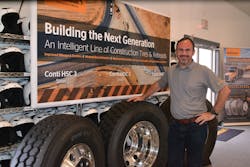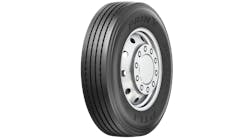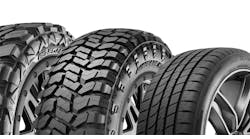Continental Tire the Americas LLC has released its first full line of construction tires with factory-embedded sensors for monitoring pressure and temperature to the North American market.
The new “intelligent” tires are the Conti HSC 3 steer/all-position tire with a matching retread, the Conti HDC 3 drive tire with a matching retread, and Conti HAC 3 all-position tire.
The numeral “3” refers to Continental’s third-generation tire technology, which the company says is responsible for significant improvements in mileage, stone retention, cut and chip compounding, and casing durability versus earlier tire models. The new line replaces Continental HSC1 and HDC1 tires.
Continental’s Generation 3 tires are designed to deliver high performance in mileage, durability, traction, and retreadability, which are key aspects for lowest overall driving cost in the on/off-road segment. The line targets the construction, cement, utility, emergency vehicle, forestry and logging applications.
Conti HSC 3
Conti HSC 3, a steer/all-position construction tire, delivers significant benefits over its predecessor, HSC1, including an estimated 11% mileage improvement, according to Continental officials.
Built on Continental’s 3G casing for reduced heat build-up and improved retreadability, the tire also features a wider tread platform to increase mileage. Its off-road belt package provides improved penetration resistance. And Continental says the tire’s new cap/base tread compounds delivered a 100% improvement in belt cut reduction during cut-and-chip testing, as well as reduced heat build-up.
The Conti HSC 3 has a 24/32-inch tread depth and is currently available in the following sizes: 11R22.5 LRH, 11R24.5 LRH, and 315/80R22.5 LRL. A matching retread, ContiTread HSC 3 – in 210 mm, 220 mm, 230 mm, and 240 mm widths – also is available.
The Conti HSC 3 competes with the Michelin X Works Z, Bridgestone M853, and Goodyear G751 MSA tires.
Conti HDC 3
Continental says the Conti HDC 3, a drive-axle construction tire, provides an estimated 15% improvement in life expectancy over its predecessor, the HDC1.
The tire’s new tread pattern delivers excellent lateral traction throughout its life and features a self-cleaning design to prevent stone drilling. A broad, even-pressure footprint provides improved wear, traction, and cut resistance, according to Continental.
The Conti HDC 3 is built on Continental’s 3G casing with a 250 mm-wide tread platform, which the company says is wider than the Michelin X Works XDY, Bridgestone M799 and Continental HDC1 tires.
A wide tread platform delivers increased mileage and longer tread life, according to Continental officials. The tire also features an aggressive open shoulder design and lug design for maximum traction, excellent retreadability, and a strong, thick sidewall.
The Conti HDC 3 has a 30/32-inch tread depth and is currently available in sizes 11R22.5 LRH and 11R24.5 LRH. It is also available in a matching retread, ContiTread HDC 3, in 210 mm, 220 mm, 230 mm, 240 mm, and 250 mm widths. The Conti HDC 3 competes against the Michelin X Works XDY, Bridgestone M799, and Goodyear G282 MSD tires.
Conti HAC 3
Features of the new Conti HAC 3, an all-position tire for construction applications, include new cap/base tread compounds for improved mileage and traction versus its predecessor, HTC1.
With a casing designed to resist irregular wear, a self-cleaning tread pattern, and a four-belt package to resist impacts, bruises, and penetrations, the Conti HAC 3 delivers maximum hours of service, according to Continental officials. Its increased sidewall gauge adds road hazard protection.
The Conti HAC 3 is currently available in the following sizes: 385/65R22.5 LRL at 22/32-inch tread depth, and 425/65R22.5 LRL at 24/32-inch tread depth.
Continental officials say the Conti HAC 3 is intended to compete against the Michelin XZY 3, Bridgestone M854, and Goodyear G296 MSA tires.
Sensors are a ‘game changer’
The new construction tire line’s sensor technology enables Continental, tire dealers and end users to track metrics that are critical to a tire’s performance and longevity: temperature and inflation pressure. Monitoring this data ultimately lowers overall operating costs, according to Marco Rabe, director of truck tire technology.
“It doesn’t help if you just save a bit of money in the cost of the tire, or you look only at retreading,” he says.
“In the end, it’s about everything working together to optimize the performance of the tire, to optimize the performance of the vehicle and to optimize the customer’s operating cost so that he keeps coming back and we form a partnership because we’re in this for the long haul.”
Rabe says Continental believes the sensor technology is a game changer, and customers will grow to understand the value that it brings to their operations. “We’re convinced these partnerships we are building are long term, and it’s a partnership that works between us, the dealer and the customer.”
Continental officials say fleets can use the inflation pressure and temperature data captured by the sensors to reduce downtime, improve safety and fuel efficiency, and minimize labor and maintenance costs associated with tire inspections.
“Every little bit of protection you can give that tire up front pays toward the end,” says Rabe.
SYSTEMS to read tire data
Continental has multiple receiver systems to read the data captured by its tire sensors. The systems can be combined to generate reports and analyses that help fleets optimize their routes and vehicles.
The ContiConnect system is designed for highway commercial operations. Continental officials say ContiConnect is ideal for fleets whose trucks or buses return to their terminals daily.
The system’s yard reader station, which is mounted in the fleet yard, collects data from all tire sensors within a 65-foot radius.
“ContiConnect is an accessible solution for domiciled fleets, such as those used in construction and regional hauling,” says Michelle Reinhart, Continental’s head of digital solutions for commercial vehicle tires in the Americas region.
“We don’t charge by vehicle. The yard reader picks up all the tire sensors within range and delivers the data to the web portal. The portal sends text and email alerts if low pressure or high temperature thresholds are breached, and trigger levels can be set by each fleet. This allows the maintenance manager to confirm proper tire pressure before vehicles leave the fleet yard, and as soon as they return.”
While ContiConnect is designed for domiciled fleets, the ContiPressureCheck system is for fleets whose trucks or buses are away from the terminal for long periods of time, plus owner-operators.
ContiPressureCheck monitors a single vehicle in real-time, alerting the driver to tire pressure and temperature issues via an in-cab display.
In addition, the ContiPressureCheck system can be connected to any of Continental’s telematics partners for remote data viewing. The company’s current partners include Zonar, PeopleNet, and Geotab for truck and bus telematics, and Road Ready for trailer telematics.
“With Continental’s ContiPressureCheck system, the driver can monitor the tire pressure situation in real-time and determine whether they need to immediately pull off the road or whether they can safely make it to the next service station,” says Reinhart. “By adding a telematics integration, a fleet manager or dispatcher could help with this analysis in real-time as well.”
Continental also offers a service called ContiLogger Live for off-the-road operations. ContiLogger Live uses a telematic device with integrated sensors to measure speed, distance, location, lateral forces, road grade, production activity, tire pressure and tire temperature. The system issues warnings for critical conditions like long idling time, high ton miles per hour (TMPH), low-efficiency cycle pattern, low inflation pressure and high tire temperature.
ContiLogger Live is designed to operate independently and to monitor thousands of vehicles in off-the road mining and quarry environments. Field engineers can customize recommendations to address significant tire challenges, with suggestions aimed at optimizing tire, equipment life and operational processes.
Rabe says the ContiLogger system opens up a new world in terms of connecting the tire digitally to the vehicle. “With ContiLogger you can track exactly how the vehicle is used in the quarry or the construction site,” he notes.
“We can go back to our customers and save them 30% of their driving time and their operational time just by optimizing what they are doing every day and what truck may be more efficient than another.”
For trailers, Continental offers a stand-alone tire pressure monitoring system called ContiPressureCheck Solo. ■




